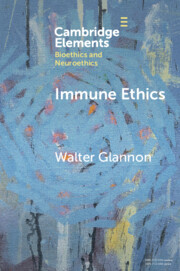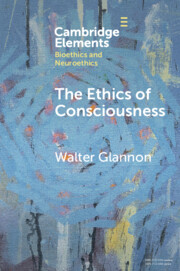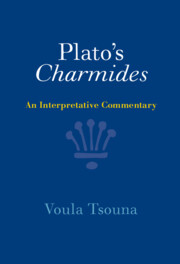39 results
Chapter 4 - Interpreting Temperance
-
- Book:
- Plato's <i>Charmides</i>
- Published online:
- 20 July 2023
- Print publication:
- 10 August 2023, pp 145-207
-
- Chapter
- Export citation
Chapter 5 - The Art of Self-Realisation
-
- Book:
- Plato's <i>Charmides</i>
- Published online:
- 20 July 2023
- Print publication:
- 10 August 2023, pp 208-252
-
- Chapter
- Export citation

Immune Ethics
-
- Published online:
- 14 July 2023
- Print publication:
- 03 August 2023
-
- Element
- Export citation
Algorithmic Credit Scoring in Vietnam: A Legal Proposal for Maximizing Benefits and Minimizing Risks
-
- Journal:
- Asian Journal of Law and Society / Volume 10 / Issue 3 / October 2023
- Published online by Cambridge University Press:
- 30 June 2023, pp. 401-432
-
- Article
-
- You have access
- Open access
- HTML
- Export citation
10 - Behavioural Health Insurance Uptake
-
- Book:
- Behavioural Incentive Design for Health Policy
- Published online:
- 18 May 2023
- Print publication:
- 01 June 2023, pp 139-148
-
- Chapter
- Export citation
Chapter 16 - Care
- from Part II - Shakespeare’s Virtues
-
-
- Book:
- Shakespeare and Virtue
- Published online:
- 19 January 2023
- Print publication:
- 26 January 2023, pp 164-171
-
- Chapter
- Export citation
How our approaches to assessing benefits and harms can be improved
-
- Journal:
- Animal Welfare / Volume 28 / Issue 1 / February 2019
- Published online by Cambridge University Press:
- 01 January 2023, pp. 107-115
-
- Article
-
- You have access
- Open access
- Export citation

The Ethics of Consciousness
-
- Published online:
- 17 June 2022
- Print publication:
- 14 July 2022
-
- Element
- Export citation
Introduction
-
-
- Book:
- Law and Legacy in Medical Jurisprudence
- Published online:
- 23 December 2021
- Print publication:
- 10 March 2022, pp 1-20
-
- Chapter
- Export citation

Plato's Charmides
- An Interpretative Commentary
-
- Published online:
- 10 February 2022
- Print publication:
- 17 February 2022
-
- Book
-
- You have access
- Open access
- Export citation
Chapter 2 - Socrates as Apprentice at Virtue
-
- Book:
- Socrates on Self-Improvement
- Published online:
- 11 June 2021
- Print publication:
- 01 July 2021, pp 21-35
-
- Chapter
- Export citation
Our Moral Duty to Eat Meat
-
- Journal:
- Journal of the American Philosophical Association / Volume 7 / Issue 3 / Fall 2021
- Published online by Cambridge University Press:
- 14 June 2021, pp. 295-311
-
- Article
-
- You have access
- Open access
- HTML
- Export citation
Chapter 14 - Do Proficient Mandarin Speakers of English Exhibit an Interlanguage–Speech Intelligibility Benefit When Tested with Complex Sound–Meaning Mapping Tasks?
- from Part IV - Accentedness and Acoustic Features
-
-
- Book:
- Second Language Speech Learning
- Published online:
- 21 January 2021
- Print publication:
- 04 February 2021, pp 350-376
-
- Chapter
- Export citation
Retrospective Benefit–Cost Analysis of Security-Enhancing and Cost-Saving Technologies
-
- Journal:
- Journal of Benefit-Cost Analysis / Volume 11 / Issue 3 / Fall 2020
- Published online by Cambridge University Press:
- 17 December 2020, pp. 479-500
-
- Article
- Export citation
16 - Variation of Trusts
-
- Book:
- A Student's Guide to Equity and Trusts
- Published online:
- 11 September 2020
- Print publication:
- 27 August 2020, pp 284-303
-
- Chapter
- Export citation
Collectives’ and individuals’ obligations: a parity argument
-
- Journal:
- Canadian Journal of Philosophy / Volume 46 / Issue 1 / February 2016
- Published online by Cambridge University Press:
- 01 January 2020, pp. 38-58
-
- Article
- Export citation
4 - Cobblers, Country Fairs, and Cross-Dressing: Benefits and the Development of Ballad Opera
- from Part I - Musical Benefits in the London Theatre: Networks and Repertories
-
-
- Book:
- Music and the Benefit Performance in Eighteenth-Century Britain
- Published online:
- 30 October 2019
- Print publication:
- 31 October 2019, pp 83-102
-
- Chapter
- Export citation
12 - Benefits: cui bono?
- from Part V - The Role of the Audience
-
-
- Book:
- Music and the Benefit Performance in Eighteenth-Century Britain
- Published online:
- 30 October 2019
- Print publication:
- 31 October 2019, pp 242-264
-
- Chapter
- Export citation
Part II - Beyond London: Mimicry or Originality?
-
- Book:
- Music and the Benefit Performance in Eighteenth-Century Britain
- Published online:
- 30 October 2019
- Print publication:
- 31 October 2019, pp 103-142
-
- Chapter
- Export citation
9 - The Mercer’s Hospital Charity Services: Music and Charity in Eighteenth-Century Dublin
- from Part IV - Charity Benefits
-
-
- Book:
- Music and the Benefit Performance in Eighteenth-Century Britain
- Published online:
- 30 October 2019
- Print publication:
- 31 October 2019, pp 187-201
-
- Chapter
- Export citation



